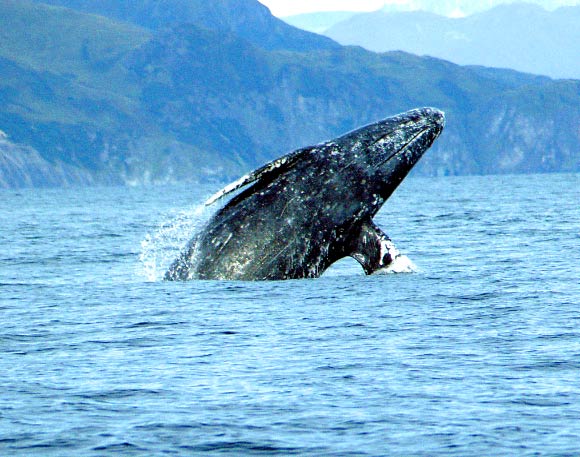Varvara, a female western gray whale (Eschrichtius robustus), swam from northeastern Sakhalin Island to Mexico and back again – nearly 22,500 km (14,000 miles) – in 172 days, says a group of scientists led by Dr Bruce Mate of the Oregon State University’s Marine Mammal Institute.

The gray whale (Eschrichtius robustus). Image credit: Merrill Gosho / NOAA.
Gray whales are well-known for their long-distance migrations between low-latitude calving and mating grounds near continental coasts and high-latitude feeding grounds in the Arctic and Sub-Arctic.
The species is distributed in an eastern North Pacific population and a western North Pacific population, with the latter listed as critically endangered on the IUCN Red List of Threatened Species.
According to marine biologists, only some 150 individuals remain in the western North Pacific.
Dr Mate and his colleagues used satellite-monitored tags to track three western gray whales from their primary feeding ground off Sakhalin Island across the Pacific Ocean and down the West Coast of the United States to Baja, Mexico.
One of the tagged whales, named Varvara, visited the three major breeding areas for eastern gray whales. Her 22 511 km round-trip, according to Dr Mate’s team, is the longest documented mammal migration.
“The fact that endangered western gray whales have such a long range and interact with eastern gray whales was a surprise and leaves a lot of questions up in the air. Past studies have indicated genetic differentiation between the species, but this suggests we may need to take a closer look,” said Dr Mate, who is the lead author of the paper published online in the journal Biology Letters.
“The ability of the whales to navigate across open water over tremendously long distances is impressive and suggests that some western gray whales might actually be eastern grays. But that doesn’t mean that there may not be some true western gray whales remaining.”
“If so, then the number of true western gray whales is even smaller than we previously thought,” Dr Mate said.
_____
Bruce R. Mate et al. Critically endangered western gray whales migrate to the eastern North Pacific. Biology Letters, published online April 15, 2015; doi: 10.1098/rsbl.2015.0071







